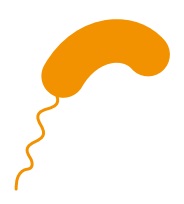Dr. Gino Corsini Acuña
Science Communication Center
|
ESCHERICHIA COLI
This bacterium is commonly found in the human
and other animals’ intestine. It can be pathogenic
when the bacterium contaminates food and this
food is eaten. The symptoms can be diarrhea, vomiting, and fever. One strain of E. coli, called E. coli
O157:H7 or enterohemorrhagic (EHEC) is very
dangerous and it causes bloody diarrhea. This strain
can result in kidney failure by the effect of a toxin.
|

|

|
LISTERIA MONOCYTOGENES
These bacteria enter the body through the gastrointestinal tract. Here, the phagocytes internalize them, which enable bacteria to proliferate and
spread, because it is an intracellular pathogen.
When it goes into the bloodstream, it can cause
sepsis or meningitis.
|
|
CAMPYLOBACTER
Humans can get it by eating contaminated food.
It is the most common cause of bacterial diarrhea
in children.
|

|

|
VIBRIO PARAHAEMOLYTICUS
This bacterium can be found in estuaries, seawater,
and some organisms, such as filter-feeding bivalve
mollusks (ribbed mussel, abalones, mussel, clams,
oysters, etc.). This bacterium causes gastroenteritis with an incubation period of 12 to 48 hours. In
general, the infection tends to run its course in two
to three days.
|
33


